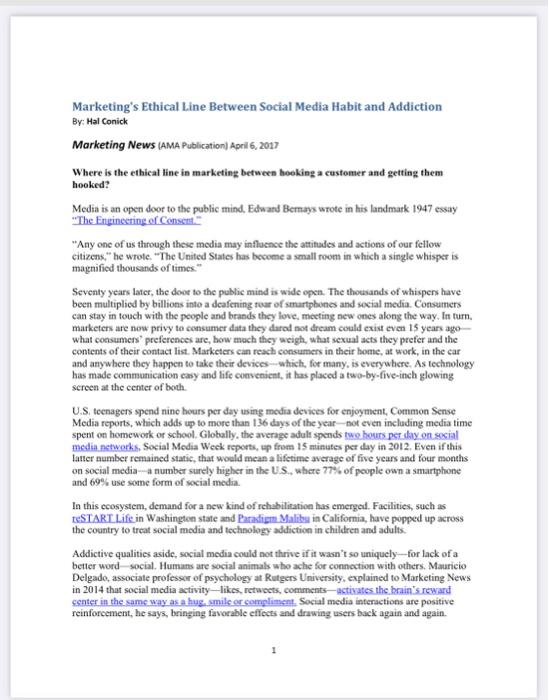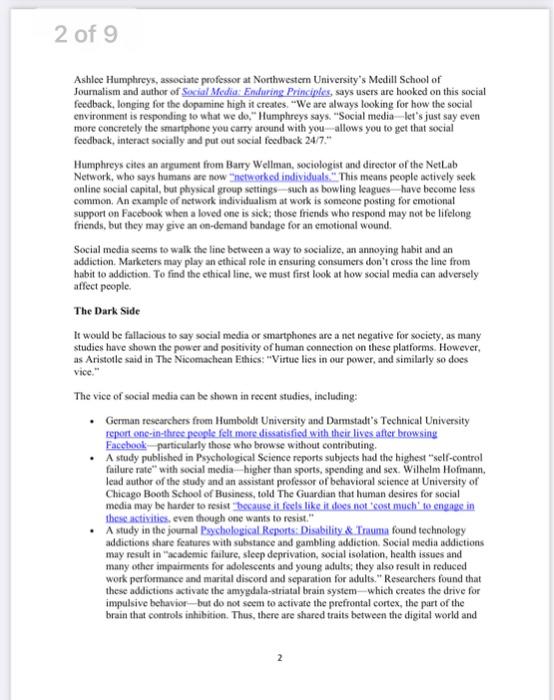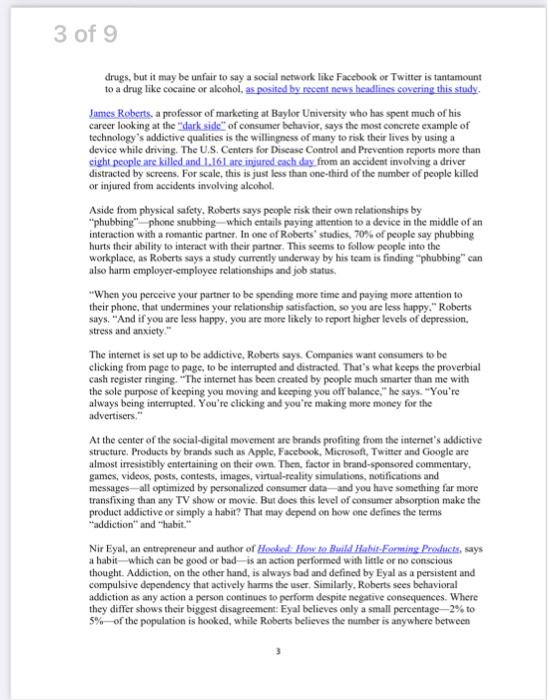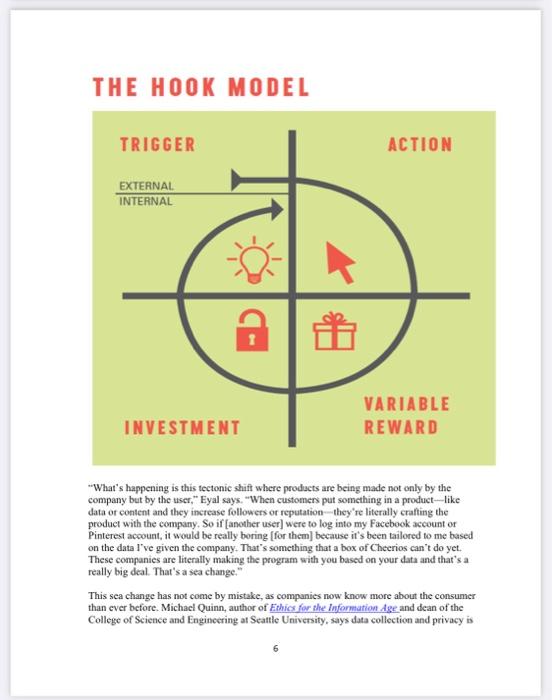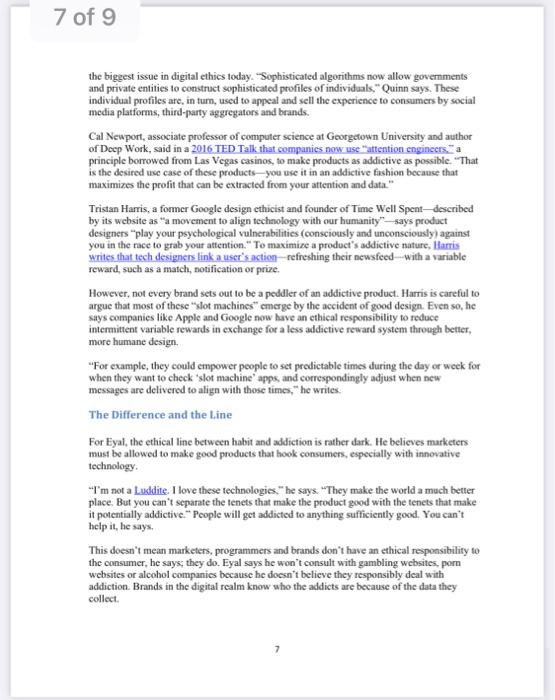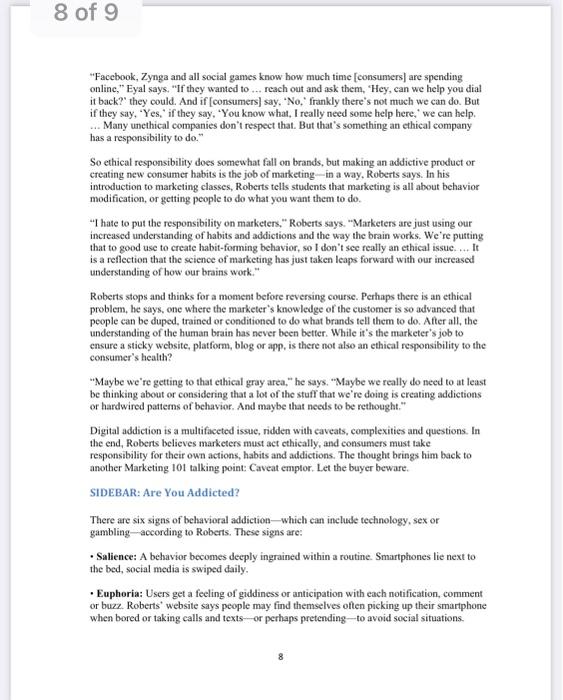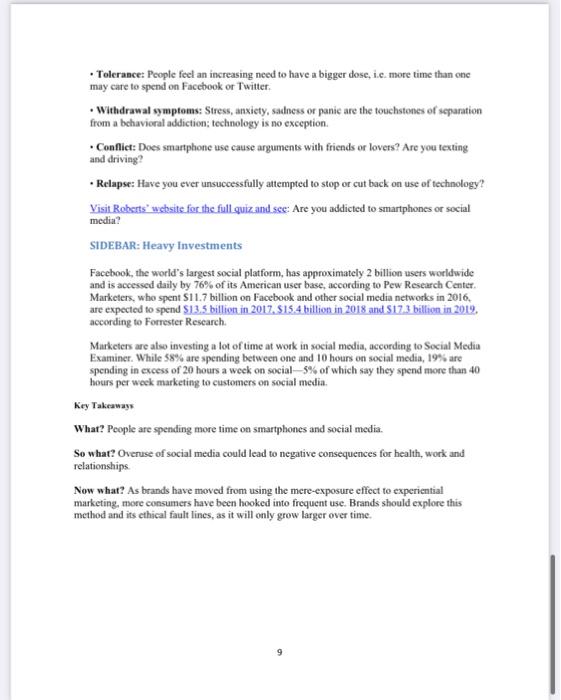Question 3: What can be done (and by whom) to limit the role of social media to creating and sustaining habits?
Marketing's Ethical Line Between Social Media Habit and Addiction By: Hal Conick Marketing News (AMA Publication) April 6, 2017 Where is the ethical line in marketing between booking a customer and getting them hooked? Media is an open door to the public mind, Edwand Bemays wrote in his landmark 1947 essay "The Engineering of Censcts" "Any one of us through these media may inflacnce the attitades and actions of our fellow citizens," he wrote. "The United States has become a small roon in which a single whisper is magnified thousands of times." Seventy years later, the door to the pullic mind is wide open. The thousands of whispen have been multiplied by billions into a deafening roar of smartphones and social media. Consumers can stay in touch with the people and brands they love, mecting new ones along the way. In turn. marketers are now privy to consumer data they darat not dream could exist even 15 years agowhat consumers' preferences are, how mach they weigh, what sexual acts they prefer and the contents of their contact list. Marketers can reach consumers in their bome, at work, in the car and anywhere they happen to take their devices - which, for many, is everywhere. As technology has made communication casy and life convenicet, it has placed a two-by-five-inch glowing screen at the center of both. U.S. teenagers spend nine bours per day using modia deviees for enjoyment, Common Sense Media reports, which adds up to more than 136 days of the year- not even including media time spent on homework or school. Globally, the average adul! spends twe hours per thay on social median networks, Social Media Week reports, up from 15 minutes per day in 2012 . Even if this Latter number remained static, that would mean a lifetime average of tive years and four monts on social media - a number surely higher in the U.S., where 77% of people own a smartphone and 69% use some form of social media. In this ccosystem, demand for a new kind of rehabilination has emerged. Facilities, such as teSTART Life in Washingten state and Pradigen Malitu in Califormia, have popped up across the country to treat social media and technology addiction in children and adults. Addictive qualities aside, social media could not thrive if it wasn't so uniquely-for lack of a better word social. Humans are social animals who ache for connection with others. Mauricio Delgado, associate professor of psychology at Rutgers University, explained to Marketing News in 2014 that social media activity-likes, retweets, comments-activates the brain's reward center in the same way as a hug, smile or compliment, Social media interactions are positive reinforcement, he says, bringing favorable effects and drawing users back again and again. Ashlee Humphreys, associate professor at Northwestern University's Medill School of Journalism and author of Socrial Medig: Enfluring Principles, says users are hooked on this social feedback, longing for the dopamine high it creates, "We are always looking for how the social environment is responding to what we do," Humphreys says. "Social media-let's just say even more concretely the smartphone you carry around with you-allows you to get that social feedback, interact socially and put out social foedback 24/7. Humphreys cites an argument from Barry Wellman, sociologist and director of the NetLab Network, who says hamans are now "nctworked individuals." This means people actively seek online social capital, but physical group scttings-such as bowling leagues- have become less common. An cxample of network individualism at work is someone posting for emotional support on Facebook when a loved one is sick; those friends who respond may not be lifelong friends, but they may give an on-demand bandage for an emotional wound. Social media seems to walk the line between a way to socialize, an annoying habit and an addiction. Marketers may play an ethical role in ensuring consumers don't cross the line from habit to addiction. To find the cthical line, we must first look at how social media can adversely affect people. The Dark Side It would be fallacious to say social media or smartphones are a net negative for society, as many studies have shown the power and positivity of human connection on these platforms. However, as Aristotle said in The Nicomachean Ethics: "Virtue lies in our power, and similarly so does vice, The vice of social media can be shown in recent studies, including: - German researchers froen Humboldt University and Darmistadt's Technical University report one-in-three neople felr more dissatisfied with their lives after browsing Facchook-particularly those who browse without contributing, - A study published in Psychological Science reports subjects had the highest "self-control failure rate" with social media-higher than sports, spending and sex. Wilhelm Hofmann, lead author of the study and an assistant professor of behavioral science at University of Chicago Booth School of Business, told The Guardian that human desires for social media may be hander to resist tockause it focls like it flecs not 'cost much't to engage in theyc activitics, even though one wants to resist." - A study in the joumal Psychological Reports: Disbility \& Trauma found technology addictions khare features with substance and gambling addiction. Social media addictions may result in "academic failure, sleep deprivation, social isolation, health issues and many other impairments for adoleseents and young adults; they also result in reduced work performance and marital discord and separation for adults." Researchers found that these addictions activate the amygdala-striatal brain system - which creates the drive for impulsive behavior-bet do not seem to activate the prefrontal cortex, the part of the brain that controls inhibition. Thus, there are shared traits between the digital world and 2 drugs, but it may be unfair to say a social nctwork like Faccbook or Twitter is tantamount to a drug like cocaine or alcohol, as posited by necent news headlines covering this study, James Roberts, a professor of marketing at Baylor University who has spent much of his career looking at the "dark side" of consumer behavior, says the most concrete example of technology's addictive qualitics is the willingness of many to risk their lives by using a deviee while driving. The U.S. Centers for Disease Control and Prevention reports more than cight people.are killed and 1.16l are inured each day from an accident involving a driver distracted by screens, For scale, this is just less than one-third of the number of people killed or injured from accidents involving alcohol. Aside from physical safety, Roberts says pcople risk their own relationships by "phubbing" phone snubbing- which entails paying altention to a device in the middle of an interaction with a romantic partncr, In one of Roberts' studies. 70%w of people say phubbing hurts their ability to interact with their partner. This secms to follow people into the workplace, as Roberts says a study currently underway by his team is finding "phubbing" can also harm employer-employee relationships and job status. "When you perceive your purtner to be spending more time and paying more attention to their phone, that undermines your relationship satisfaction, so you are less happy, Roberts says. "And if you are less happy, you are more likely to report higher levels of depression, stress and anxicty. The internet is set up to be addictive, Roberts ayk. Companies want consumen to be clicking from page to page, to be interrupted and distracted. That's what kecps the proverbial cash register ringing. "The internet has been created by people much smarter than me with the sole purpore of kecping you moving and kecping you off balance," he says. "You're always being interupted. You're clicking and you're making more money for the advertisers," At the center of the social-digital movement are brands profiting from the internet's addictive structure, Products by brands such as Apple, Facebook, Microsoft, Twitter and Google are almost irresistibly entertaining on their own. Then, factor in brand-sponsored commentary, games, videos, posts, contests, images, virtual-realify simulations, notifications and messages-all optimized by personalized consurmer data-and you have sorsething far more transfixing than any TV show or movie. But does this level of consamer absorption make the product addictive or simply a habit? That may depend on how one defines the terms "addiction" and thabit." Nir Eyal, an entrepreneur and author of Hoaliet Hosy fo Ruifal Habit. Fomerime Prowhers, says a habit - which can be good or bad-is an action performed with little or no conscious thought. Addiction, on the other hand, is always bad and defincd by Eyal as a persistent and compulsive dependency that actively harms the user, Similarly, Roberts sees behavioral addiction as any action a person continues to perform despite negative consequences. Where they differ shows their biggest disagreement: Eyal believes only a small percentage- 2% to 5% of the population is hooked, while Roberts believes the number is anywhere between 3 50% and 66% of U.S. citizens. Researebers from the aforementioned study in Disability \& Trauma believe anywhere from 0.7%6 to 11% of the population is addicted to technology. A matter for marketers, then, is what role brands are playing in the increased consumption of social media. Are brands simply practicing good marketing or are they taking advantage of their advanced knowledge of what makes the average human brain tick? Could the virtue of good marketing - which as Aristotle noted lies in power-tura inte a vice? The Shift from Mere-exposure to Experiential Marketing Since the start of the 21 at century, there's been an important poychological shift in marketing The mere-evposure effect-defined by PsychCentral as a preference for people or things simply because they're familiar - dominated advertising and marketing in the 20th century. The theory works like this: The moee a brand exposes itself to consumers on TV, in magazines, in newspapers or on billboards, the more censumers gron familiar with the brand. Exposure and familiarity mean increased sales. However, many modem companies don't rely on the mere-exposure effect anymore, according to Eyal. Consider how rarely you see billboards or ads for Snapchat or Facebook. Instead, brands use experiences to implant themselves in the consumer's mind; using an app, playing a game, watching a video or reading content. "The products themselves change consumer behavior and tastes; it's through forming habits with the product," Eyal says. "The product experience itself is what makes people use them more. That's different. That's news. That's something only this century that we've seen." The best products don't win, Eyal says, but products that have monopoly of the mind do. Take the phrase "search engine," for example: Does anyone's mind immediately think Yahoo or Bing? Without much conscious thought-perhaps as simple as the unconscious stroke of the letter " G " on the keyboard -Google likely flashes to mind How do brands win monopoly of the mind? Eyal breaks down the four basic steps of the hook model: a trigger, an action, a reward and an investment. Brands identify the consumer's initial trigger and the trigger's accompanying emotions, in the process allowing consumers to easily collect rewards. The hook for rewands becomes more enticing on a variable schedule instead of a fixed schedule; Eyal says this is the same psychology at work as pulling the handle of a slot machine. The best example of this may be the social media newsfeed, which users continuously scroll through and pull down to refresh. What pulls the hook model together is investment, the final step of experiential marketing, which Eyal says can only be done by interactive products. "What's happening is this tectonic shift where products are being made not only by the company but by the user," Eyal says, "When customers put something in a product-like data or content and they increase followers or reputation - they're literally crafting the product with the company, So if [another user] were to log into my. Facebook account or Pinterest aceount, it would be really boring [for them] because it's been tailored to me based on the data I've given the company. That's something that a box of Cheerios can't do yet. These companies are literally making the program with you based on your data and that's a really big deal. That's a sea change," This sea change has not come by mistake, as comaunies now know more about the consumer than ever before. Michacl Quinn, author of and dean of the College of Science and Engineering at Seattle University, says data collection and privacy is the biggest issue in digital ethics today. "Sophisticated algorithms now allow govemments and private entities to construct sophisticated profiles of individuals," Quinn says. These individual profiles are, in turm, used to appeal and sell the experience to consumers by social media platforms, third-party aggregators and brands. Cal Newport, associate professor of computer science at Georgetown University and author of Deep Work, said in a 2016 TED Talk that companies now use "attention engineers." a principle borrowed from Las Vegas casinos, to make products as addictive as possible. "That is the desired wee case of these products - you use it in an addictive fishion because that maximizes the profit that can be extracted from your attention and data. " Tristan Harris, a former Google design ethicist and founder of Time Well Spent-described by its website as "a movement to align technology with our humanity'-says product designers "play your psychological vulnerabilitics (consciously and unconsciously) against you in the race to grab your attention." To maximize a product's addictive nature, Harris writes that tech designers link a user's action-refreshing their newsfeed-with a variable reward, such as a match, notification or prize. However, not every brand sets out to be a peddler of an addictive product. Harris is careful to argue that most of these "slot machines" emerge by the accident of good design. Even so, he says companies like Apple and Google now have an ethical responsibility to reduce intermittent variable rewards in exchange for a less addictive reward system through better, more humane design. "For example, they could empower people to set predictable times during the day or week for when they want to check 'slot machine' apps and correspondingly adjust when new messages are delivered to align with those times," he writes. The Difference and the Line For Eyal, the ethical line between habit and addiction is rather dark. He believes marketers must be allowed to make good products that hook consumers, especially with innovative technology. "I'm not a Luddite. I love these technologies," he says. "They make the world a much better place. But you can't separate the tenets that make the product good with the tenets that make it potentially addictive. " People will get addicted to anything sufficiently good. You can't help it, he says. This doesn't mean marketers, programmers and brands don't have an ethical responsibility to the consumer, be says; they do. Eyal says he won't consult with gambling websites, porn websites or alcohol companies because he doesn't believe they responsibly deal with addiction. Brands in the digital realm know who the addicts are because of the data they collect. "Facebook, Zynga and all social games know how much time [consumers] are spending online," Eyal says. "If they wanted to ... reach out and ask them, 'Hey, can we help you dial it back?' they could. And if [consumers] say, "No," frankly there's not much we can do. But if they say, 'Yes,' if they say, 'You know what, I really need some help here,' we can help. ... Many unethical companies don't respect that. But that's something an ethical company has a responsibility to do." So ethical responsibility does somewhat fall on brands, but making an addictive product or creating new consumer habits is the job of marketing - in a way, Roberts salys. In his introduction to marketing classes, Roberts tells students that marketing is all about behavior modification, or getting people to do what you want them to do. "I hate to put the responsibility on marketers," Roberts says. "Marketers are just using our increased understanding of habits and addictions and the way the brain works. We're putting that to good use to create habit-forming behavior, so 1 don't see really an ethical issue.... It is a reflection that the science of marketing has just taken leaps forward with our increased understanding of how our brains work." Roberts stops and thinks for a moment before reversing course. Perhaps there is an ethical problem, he says, one where the marketer's knowledge of the customer is so advanced that people can be duped, trained or conditioned to do what brands tell them to do. After all, the understanding of the human brain has never been better. While it's the marketer's job to ensure a sticky website, platform, blog or app, is there not also an ethical responsibility to the consumer's health? "Maybe we're getting to that ethical gray area," he says. "Maybe we really do need to at least be thinking about or considering that a lot of the stuff that we're doing is creating addictions or hardwired patterns of behavior. And maybe that needs to be rethought." Digital addiction is a multifaceted issue, ridden with caveats, complexities and questions. In the end, Roberts believes marketers must act ethically, and consumers must take responsibility for their own actions, habits and addictions. The thought brings him back to another Marketing 101 talking point: Caveat emptor. Let the buyer beware. SIDEBAR: Are You Addicted? There are six signs of behavioral addiction - which can include technology, sex or gambling-according to Roberts. These signs are: - Salience: A behavior becomes deeply ingrained within a routine. Smartphones lie next to the bed, social media is swiped daily. - Euphoria: Users get a feeling of giddiness or anticipation with each notification, comment or buzz. Roberts' website says people may find themselves often picking up their smartphone when bored or taking calls and texts - or perhaps pretending - to avoid social situations. 8 - Tolerance: People feel an increasing need to have a bigger dose, i.e. more time than one may care to spend on Facebook or Twitter. - Withdrawal symptoms: Stress, anxicty, sadness or panic are the touchstones of separation from a bchavioral addiction; technology is no exception. - Conflict: Does smatphone use cause arguments with friends or lovers? Are you texting and driving? - Relapse: Have you ever unsuccessfully attempted to stop or cut back on use of technology? Visit Roherts" website for the full quiz and see: Are you addicted to smartphones or social media? SIDEBAR: Heavy Investments Facebook, the world's largest social platform, has approximately 2 billion users worldwide and is aceessed daily by 76% of its American user base, according to Pew Research Center. Marketers, who spent $11.7 billion on Facebook and other social media networks in 2016. are expected to spend $13.5 billion in 2017.$15.4 billion in 2018 and $17.3 billion in 2019 . according to Forrester Research. Marketers are also investing a lot of time at work in social media, according to Social Media Examiner. While 58% are spending between one and 10 hours on social media, 19% are spending in excess of 20 hours a week on social- 5% of which say they spend more than 40 hours per weck marketing to customers on social media. Key Takeaways What? People are spending more time on smartphones and social media. So what? Overuse of social media could lead to negative consequences for health, work and relationships. Now what? As brands have moved from using the mere-exposure effect to experiential marketing, more consumers have been hooked into frequent use. Brands should explore this method and its ethical fault lines, as it will only grow larger over time
